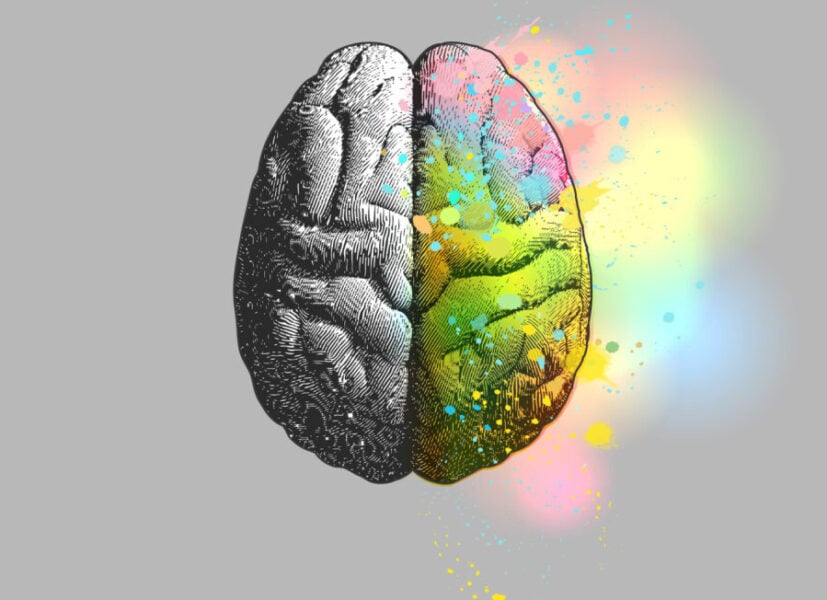A new theory suggests that psychedelic substances may achieve their profound effects by temporarily shifting the brain’s balance of power from the typically dominant left hemisphere to the right.
This proposed explanation, published in the Journal of Psychopharmacology, could help explain why these drugs consistently produce similar patterns of enhanced empathy, creativity, and connectedness across different individuals and substances. The model challenges traditional views of how psychedelics work in the brain and potentially bridges the gap between modern neuroscience and ancient healing traditions.
Introducing the HEALS Model
Dr. Adam Levin, a psychiatrist and postdoctoral scholar at Ohio State University’s Center for Psychedelic Drug Research and Education, calls his proposed framework HEALS: Hemispheric Annealing and Lateralization Under Psychedelics. The theory suggests that psychedelics fundamentally alter the relationship between the brain’s hemispheres.
“In the psychedelic state, there’s a unique combination of the hemispheres coming together in a way that doesn’t usually happen in normal states of consciousness,” Levin explains. “It’s almost a new encounter between the left and the right hemispheres’ way of thinking and perceiving the world.”
Unlike pop psychology’s simplistic “left-brain logical, right-brain creative” division, Levin’s model focuses on how each hemisphere approaches perception and processes information. While conventional consciousness favors the left hemisphere’s narrow, focused approach, psychedelics may temporarily elevate the right hemisphere’s broader, interconnected perspective.
The Two Hemispheres’ Different “Worldviews”
Neuroimaging studies analyzed by Levin revealed increased activity in the right frontal lobe and an overall rightward shift in brain metabolism under psychedelics. This pattern aligns with the distinctive cognitive and emotional changes commonly reported during psychedelic experiences:
- Broader attention span with heightened interest in novelty and living things
- Enhanced emotional and social intelligence
- Increased creativity, psychological flexibility, and insight
- Greater sense of connection to others and the natural world
- Shift toward metaphorical thinking and heightened music appreciation
According to Levin, these changes closely mirror the right hemisphere’s natural mode of perception, which typically operates in the background of everyday consciousness. “Those general patterns are awfully similar to the pattern of the right hemisphere,” he notes. “And I think psychedelics provide access to this whole picture, this whole view, that could have been operating in the background – and that’s this right hemisphere view.”
Clinical Observations Support the Theory
Levin’s clinical experience with stroke patients provided a compelling parallel. “In people who lose the right hemisphere to stroke, the attentional window gets so narrow and they don’t even recognize a whole half of the world. Whereas people with an intact right hemisphere, who lose their left hemisphere, still have a broader general picture of things,” he said. “A lot of these people’s experiences seem, to me, to be similar to what I’m seeing in my psychedelic research.”
The HEALS model may help explain why psychedelic experiences often feel paradoxically both novel and familiar. Rather than creating entirely new mental states, these substances may be enhancing an existing mode of perception that’s normally subordinate to left-hemisphere dominance.
Connections to Mindfulness and Traditional Healing
Intriguingly, the theory connects psychedelics to other practices known to enhance right-hemisphere function. Mindfulness meditation, for example, has been shown to build new neural networks and increase brain thickness in the right hemisphere over time.
“Psychedelics have been linked to improvements in mindfulness with just one or two uses. And sometimes these capacities are almost at levels consistent with practiced meditators,” Levin observes. “That makes it likely, to me, that many core right-sided networks that are enhanced with practicing meditation might be enhanced briefly, or maybe longer, through psychedelics.”
This perspective may also explain why indigenous healing traditions often describe psychedelics as restoring natural balance rather than creating artificial states. If psychedelics temporarily elevate an existing but suppressed mode of perception, they would indeed be “rediscovering a facet of existence that is actually very basic,” as one researcher described it.
Complementing Other Theories
While existing models of psychedelic action focus on top-down versus bottom-up processing or the brain’s dorsal-ventral axis, Levin’s theory addresses the often-neglected lateral axis – the relationship between right and left hemispheres. Rather than replacing current frameworks, HEALS complements them by explaining why psychedelic experiences follow predictable patterns rather than resulting in random neural activity.
Could this new perspective open doors to more targeted therapies or help integrate psychedelic insights into everyday consciousness? Levin believes expanding research will stimulate more questions and theories that collectively paint a more complete picture. “I think to explain something as complex as the brain, especially in the human being, you need a variety of theories to more closely approximate what’s actually happening,” he said. “If we get too fixated on one explanation or the other, we’re going to lose track of reality.”
If our reporting has informed or inspired you, please consider making a donation. Every contribution, no matter the size, empowers us to continue delivering accurate, engaging, and trustworthy science and medical news. Independent journalism requires time, effort, and resources—your support ensures we can keep uncovering the stories that matter most to you.
Join us in making knowledge accessible and impactful. Thank you for standing with us!

